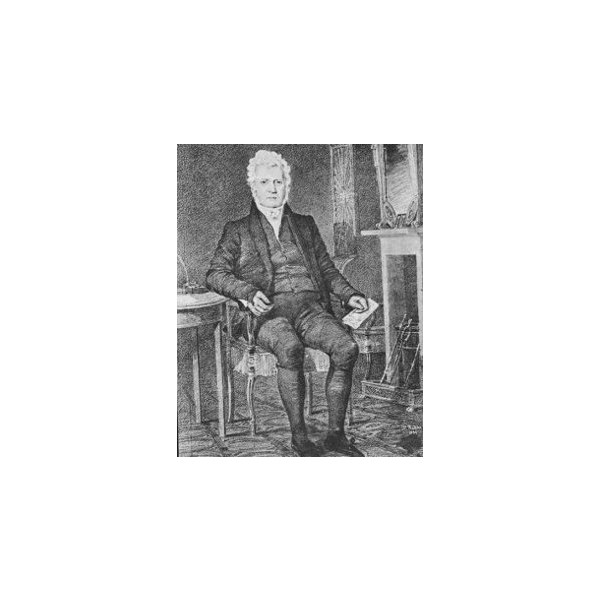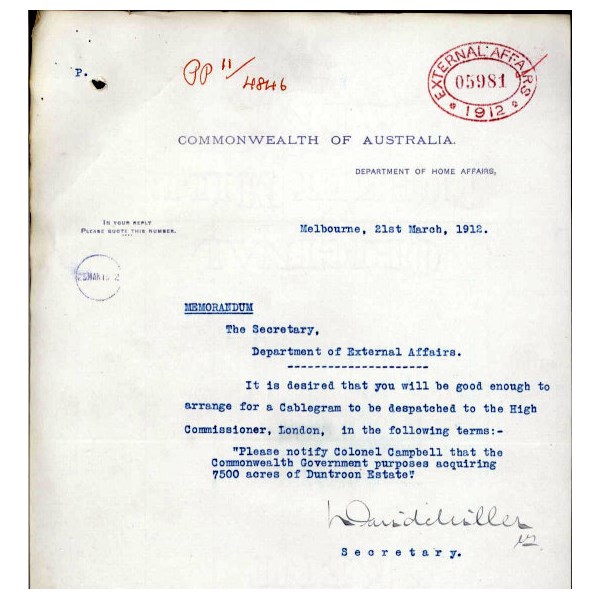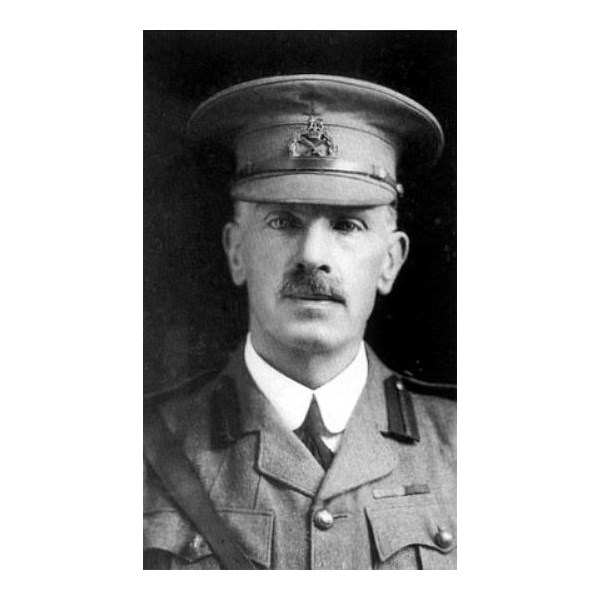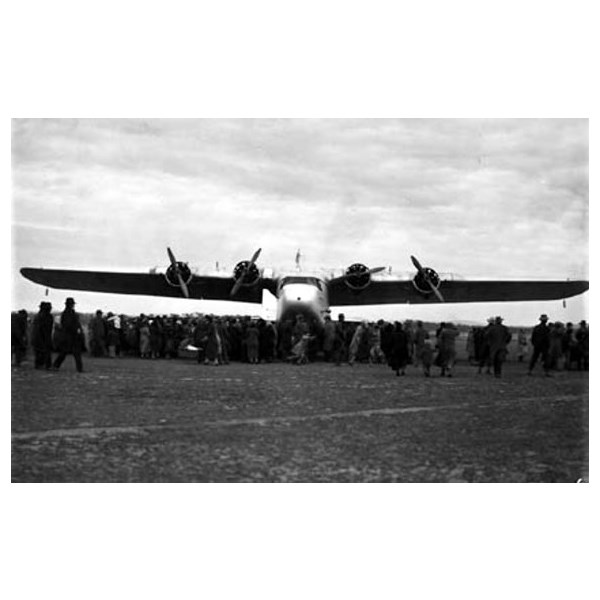Robert Campbell's property Duntroon was situated on the
limestone plains of New South Wales in the area that is now covered by the ACT.
Given government compensation for the loss of his ship the
Sydney while under government charter, Robert Campbell, sent James Ainslie to collect 700 sheep from the government flocks at
Bathurst and to go southward looking for suitable pasture.
Ainslie reached the
Limestone Plains and selected a site on the slopes above the Molonglo River where the Royal Military College now stands. In 1825 Campbell applied for and received his grant, naming it 'Duntroon' after the family castle, Duntrune Castle on
Loch Crinan in Argyll, Scotland.

Robert Campbell (1769-1846), by unknown artist
In 1833, Campbell built 'Duntroon House' out of stone with wide verandahs. In 1862 Robert's son George added a large two-storey extension. In its final form the house contained twenty rooms and is a great example of colonial architecture. It now serves as the officer's mess for the Royal Military College, Duntroon and is situated in the suburb of Campbell,
Canberra.
'Duntroon House' was the centre of activity for Campbell's station. Gardens were established around the house including many exotic trees and an intricate maze was grown also a conservatory, orchard, vineyard and dairy farm were built in the surrounding area.

Dept' Home Affairs 1910

Dept' Home Affairs 1912

Duntroon house in 1870
Duntroon was recommenced as the site for Australia's Military College by Lord Kitchener, who had been commissioned in 1910 to report on the country's defence needs. Initially the government rented Duntroon for two years before obtaining the title to Duntroon and its surrounding 360 acres through the creation of the Australian Capital Territory.
The Royal Military College, Duntroon was opened on 27 June 1911 by
the Governor-General, Lord Dudley. Situated on the Campbell family
homestead in
Canberra, the college was one of the first Commonwealth facilities established in the newly created capital. The Australian Government first rented the Duntroon
homestead for two years (November 1910 – July 1912) and finally acquired the freehold to the estate and 370 acres of land after the creation of the federal capital.
The first Commandant of the college was Brigadier General William Bridges, who later died on a hospital ship after being wounded by a sniper on the shores of Gallipoli. Under his recommendations the college was modelled on aspects from the Royal Military College of Canada and the military colleges of Britain, and the
United States of America. Several British officers, including Lieutenant Colonel Charles Gwynn as Director of Military Art, were assigned as faculty to the newly established college. During Bridges' frequent absences, Gwynn served as acting Commandant.

Major General Sir William Throsby Bridges KCB CMG

First Class of cadets at Royal Military College Duntroon 19161919
The First World War provided the college with its first chance to demonstrate its worth. However, when the war broke out in August 1914, there had not been enough time for the first class to complete the full Duntroon course. Nevertheless, it was decided to graduate the class early so that they could be sent over to Gallipoli, where General Sir Ian
Hamilton, commander of the Mediterranean Expeditionary Force, said that "...each Duntroon educated officer was...worth his weight in gold". During the war 158 Duntroon graduates had been sent overseas on active service, of which 42 were killed or died of wounds and another 58 were wounded.
Over the years, however, with the impact of the two World Wars, the duration and focus of the course changed as the requirements of the Army dictated. For a short period of time in the 1930s the college was forced to relocate to the Victoria Barracks,
Sydney, due to the economic downturn caused by the Great Depression. During the Second World War short courses of between six months and a year were run, and ultimately 696 graduates of the College undertook active service overseas in either the Australian, British or New Zealand armed forces, while a further 122 former cadets who had not graduated served in varying capacities. Of these 122, three went on to have quite distinguished careers, with one rising to the rank of brigadier in the Australian Army, another to brigadier in the New Zealand Army and a third, R.C. McCay, reaching the rank of lieutenant general and serving in the British Indian Army and then becoming chief-of-staff of the newly formed Pakistan Army.

Imperial Airways Airliner ASTRAEA on a survey flight for proposed air mail service, at Duntroon landing ground 1933

Aerial view of the Royal Military College at Duntroon 1946
Following the war, the length of the course was set at four years again and efforts were made to increase the level of academic rigour in the college's programs. This culminated in 1967 when the college affiliated with the University of New South Wales (UNSW) to offer Bachelor courses in Arts, Science or Engineering, commencing in the 1968 academic year. Under this program, the first degrees from RMC were awarded in 1971. In order to graduate, cadets had to achieve passes in both military and academic studies and leadership. The link with UNSW was almost severed in 1969 when Duntroon was the centre of an inquiry after Gerry Walsh, a member of the academic staff, revealed details of hazing told to him by a student at the college. The inquiry resulted in at least one army career ending, while other personnel were severely punished.
With the closure of the Officer Cadet School, Portsea, in December 1985, and the closure of the Women's Officer Training Wing at Georges Heights,
Sydney, in December 1984, the Royal Military College, Duntroon became the sole General Service Officer training institute in the Australian Army, as all Regular Army officers serving in combat, combat support or service support Corps were required to attend Duntroon in order to be commissioned. Shortly after this, the role of the college changed again with the establishment of the Australian Defence Force Academy in 1986. As a result of this change, Duntroon ceased to offer university degrees as ADFA became responsible for the academic training of Army cadets, as
well as those from the Air Force and Navy. The same year, the college celebrated its 75th anniversary (1911–1986). As an acknowledgement of this, 33 cent stamps featuring the head of a male officer cadet were printed; the first day of issue was 27 June 1986.
.